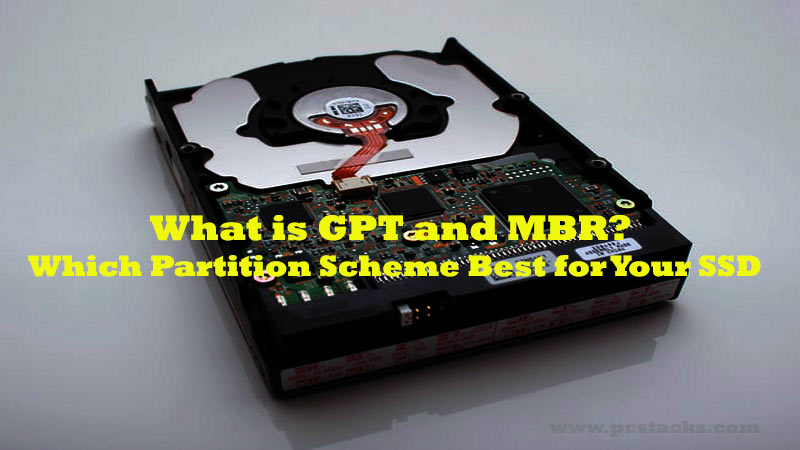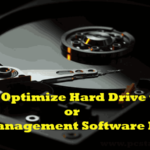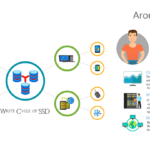Whenever you try to set up a new hard drive on your Windows OS, you will be asked to choose from MBR and GPT. Both of them play important roles in storing, locating, and accessing the information properly. Both of them have their own pros and cons.
So, when it comes to an optimal OS experience, you must pick the right one for you as per the situation. These parameters highlight the structure of information stored on your hard disk.
It means that whether you are using GPT or MBR, they are going to store from where the partition begins and where it is going to end.
It may also contain the code which will be utilized when you start your computer. So, in this article, we are going to know what is the difference between MBR and GPT? Along with that, we will cover various other things which you may find interesting to read. Both these things can help you in different ways.

So, we will guide you through each step of how you can use them for better. Not only on Windows, you may have to see both these things on Mac and other operating systems like Linux. But, they are going to serve you with the same purpose.
With the help of this article, you will never have to think about both these things whenever you try to set up your OS on a new disk. You can easily pick the right one for you because you are aware of everything required. You can choose whatever parameter and get ready to see the results effectively.
However, without a good period knowledge of these things, you can assume that you are not going to get the results you are looking for.
If you are really curious to know what are both these terms and what are the differences between them, we will help you for sure. Now, without any further discussions, let’s get started.
Table of Contents
What is Master Boot Record (MBR) and it’s boot sector partition?
MBR was initially released with IBM PC DOS 2.0 in 1983. It is named Master Boot Record since the MBR is a special boot business located in the launch of a drive. This sector includes a boot loader for the installed operating system and data regarding the driveway logical walls.
The boot loader is a small bit of code that normally heaps the larger boot loader from a different partition on a driveway. When you have Windows installed, then the first bits of that Windows boot loader reside here–that is the reason you might need to repair your MBR if it is overwritten and Windows will not start. In case you have Linux installed, then that the GRUB boot loader will generally be found at the MBR.
MBR does have its own limitations. MBR also just supports up to four primary partitions–in case you need more, you need to create one of your main partitions and an”extended partition” and make logical partitions inside. This is a ridiculous small hack and should not be necessary.
What is GUID Partition Table (GPT)?
It is a new standard that is slowly replacing MBR. GPT, then, replaces the age-old MBR partitioning system using something more contemporary. It is named GUID Partition Table since every partition on your drive includes a GUID (globally distinctive identifier). GUID is a random string provided that every GPT partition on the planet probably has its own unique identifier.
GPT does not suffer from MBR’s limits. GPT-based drives can be a lot larger, with dimension limitations determined by the operating system along with its own file systems. It’s also allows for a virtually infinite number of walls.
Again, the limitation here will probably become your working system. Windows allows up to 128 partitions onto a GPT drive, and you also do not need to produce an elongated partition to make them operate.
In an MBR disk, the boot and partitioning information is stored in 1 spot. By comparison, GPT stores multiple copies of the data throughout the disc, so it is a whole lot more robust and may recover if the information is corrupted.
GPT additionally shops CRC (Cyclic Redundancy Check) values to confirm its information is undamaged. When the information is corrupt, GPT can observe the issue and make an effort to recoup the damaging information from a different place on the disc drive.
MBR had no method of knowing if its information had been corrupt –you would only notice there was an issue once the boot procedure failed or your driver’s walls disappeared.
Which partition is better GPT or MBR?
With all the information you have received above, we can say that GPT is a good option to choose if you are using the latest Windows version after Windows XP. It will help you to create your desired types of partitions and make things better for you.
GPT is definitely more effective, robust, and great in terms of features. You should definitely try to use it on any latest computer system and make it better for you.
However, if you are in search of compatibility with the old systems, you can surely try MBR and take the features it offers. But, if we look at the latest world and today’s requirements, GPT is definitely a good option to choose from.
However, all the selections depend on you and your core requirements. Both MBR and GPT are still in use and helping people to have a better user experience. But, knowing which one to choose is definitely a good way to make your selection better.
The way these both methods help people is unmatched. But, it is always important to know your needs before making any decision. So. yes, if you have read this article properly, you might have got all the answers.
MBR vs GPT: Which Partition Style Is Better for your Computer SSD?
We started seeing the MBR in 1983. Ever since that time, the system part was utilized on the 1 hand for a boot supervisor to boot BIOS-based computer programs, and also on the flip side for a partition table to effectively divide the memory.
This second purpose is exactly what aided MBR rapidly become the norm for all sorts of storage devices, such as hard drives, USB sticks and memory cards.
More recent systems today increasingly utilize MBR’s official successor, the GUID Partition Table (GPT). This brand new partition table regular is a part of the UEFI specification that was introduced in 2000 and becoming a popular option to choose as a BIOS.
What about the redundancy?
As noticed from the arrangement, MBR shops the boot and partition info in 1 location at the start of the partition. Whether this information is corrupted or missing, then the entire OS is down since the boot loader is broken.
That is the reason why we are likely knowledgeable about the word”fixing the MBR” and a great deal of tutorial was published in the world wide web to pay about doing it. Here is the principal difference between GPT and MBR which produces GPT completely surpass MBR.
As noticed from the arrangement, GPT stores multiple copies of this boot and partition information throughout the disc. These copies may be employed to recoup the data that was broken.
Benefits and drawbacks of MBR
The MBR is saved on the primary sector of the disk and is made together with the very first partition in the drive. It’s packed into memory among the very first activities during system start up.
The disc signature is a distinctive four byte identifier for your drive, which is to say it must be unique to each drive attached to your machine.
It’s used for purposes like identifying the boot volume, and linking partitions and volumes with a certain drive.
The MBR signature, occasionally known as the magical number, is set to appreciate 0xAA55, which only defines it as a valid MBR. The partition informs of the starting location and length of every partition on the hard disk drive.
During system startup the MBR code is implemented, and is in charge of parsing the partition and differentiating that partition is marked as busy. When the active partition is recognized control is passed into the walls boot industry, sometimes known as the quantity boot record (VBR). Let’s see the benefits and drawbacks of MBR.
Benefits of MBR:
- A great option to choose for older systems and operating systems
- Stores the partition and boot data at one place at the starting
- Can create up to four primary partitions
- The extended partition can contain one or more logical drives
Drawbacks of MBR:
- Not a good option to choose for latest systems and OS
- It supports only 64 bytes partition table
- The maximum partition size is 2 TB
Benefits and drawback of GPT
Any computer using Windows Server 2003 with SP1 and later may pretty easily use a partition design called the GPT along with the traditional MBR. A simple disk with the GPT partition design may have up to 128 primary walls, whereas lively disks will have a solitary LDM partition like MBR partitioning.
The main feature which you get along with a GPT is that you can create partitions of bigger than 2 TB size. So, you do not have to create more partitions or use logical drives. It uses GUIDs which makes them suitable for any type of device including hard disks and SSDs.
There are numerous drawbacks of MBRs which we have discussed above but this one helps to overcome most of them pretty effectively. So, you should definitely be using the GPT method if you are trying to work with the latest OS such as Windows 10 etc.
Benefits of GPT:
- It will allow the partitions bigger than 2 TB
- It supports Cyclic Redundancy check protection with the partition tables
- You can add additional partition type with the help of OEM (Original Equipment manufacturer)
- It doesn’t limit you to use only four partitions
- Good for data recovery because of its robust nature
Drawbacks of GPT:
- GPT may not work well with the older Windows OS
How to convert MBR to GPT without an operating system?
After reading this article, you might be thinking about converting your system with MBR into GPT. Well, there are numerous advantages and you can be looking to use any of them. But, it is not easy to utilize them effectively because your OS may not work all the time to help you with this operation.
Fortunately, you can do this process without using any operating system as well. The only thing you have to do it to follow the process we are going to discuss here in this article below. You will be able to see great results for sure.
As the title suggests, this might sound difficult. But, actually, you can easily follow this guide and convert the MBR into GPT anytime you want.
For the beginners, the process may seem difficult but we have tried to cover the topic as proper as we can. So, let’s get started.
For this process, we are going to use Command Prompt because it is the simplest way to do the same. Now, let’s jump to the procedure here.
- Turn On your computer in the Windows Troubleshooting menu. Just insert the Windows Installation Media and press Shift+F10 to open the command prompt directly. (This method can be done in any system/laptop whether there is an OS installed or not).
- Once the command prompt is opened, enter diskpart and hit Enter
- Click Yes to proceed for opening diskpart
- Now, type list disk and hit Enter. Note down the number of disk you want to convert into GPT
- Now, type select disk 1. 1 highlights the number of disk you want to convert
- Type clean and hit Enter. Make sure to have backup before this step because this thing will wipe out all the data stored on your disk
- Now, type convert gpt and hit Enter.
Alternatively, you can download EaseUS Partition master to make this thing much easier for you. Also, you can follow the complete guide to use this software and convert MBR into GPT. The article is posted on EaseUS official site so you can follow it properly anytime you want.
Which one should you choose?
If you have read this article properly from the very beginning, you must have gathered all the required information regarding this topic. Choosing between MBR and GPT will be much easier for you now.
But, keep a thing in mind that if are dealing with a latest system, GPT should definitely be your first choice. However, if you are one who wants to utilize and older system or OS that requires MBR, you should definitely go for this one.
GPT is the most popular partition system used these days. So, without any worry, you can just go for this system and get the results you are looking for.
When it comes to the support, the GPT is supported by all the operating systems and storage devices. So, if you want, you can utilize it with any type of computer for any purpose.
Final Verdict
We hope you are now aware of the main differences between GPT and MBR. However, all the information given here is gathered from the internet and from our personal experiences. So, before proceeding to choose any of these partition systems, you should understand your requirements and then pick the right one for you. But, you have got your answer now and you may not need any other resource to get help related to this topic.
If you have liked this article, consider sharing it with others as well. You can use social media or mail for this purpose. Also, let us know what you think about this article in the comment section.
We are always ready to hear from your side. You can give us any feedback you want. Also, you can give us suggestions for further articles. We will surely try to help you with anything we can. We keep coming with regular and latest articles on technology on this blog. So, stay connected with us for more.
Thanks for reading!



